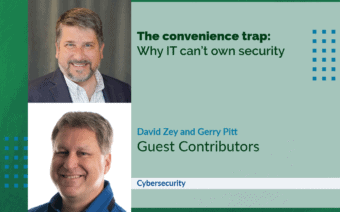June 1, 2023
What comes to mind when you hear the term “insider threat?”
Does it conjure up images of double agents and espionage?
Or maybe a shadowy figure in a basement hacking into the mainframe?
In reality, insider threats often involve ordinary individuals who typically act unintentionally, but pose significant risks for organizations of all sizes.
By understanding the nature of insider threats and implementing effective countermeasures, organizations can enhance their resilience against internal vulnerabilities.
An insider
To begin, it is crucial to define what constitutes an insider.
The federal government’s Cybersecurity and Infrastructure Security Agency (CISA) defines an insider as “any person who has or had authorized access to or knowledge of an organization’s resources, including personnel, facilities, information, equipment, networks and systems.”
An insider can include current or past employees, contractors and third-party vendors.
Insider threats are security risks originating from those individuals within an organization who possess legitimate access privileges.
These insiders may act maliciously – with intentions of financial gain, revenge or espionage; or they may unwittingly compromise security due to negligence, ignorance or falling victim to social engineering tactics.
Insider threats can manifest in various forms, such as unauthorized data access, intellectual property theft, sabotage or the introduction of malware.
Proactive steps
There are several strategies organizations can implement to detect and identify potential insider threats.
Implementing User and Entity Behavior Analytics (UEBA) solutions allow organizations to detect suspicious activities or deviations from normal patterns.
These solutions analyze user actions, such as login attempts, file access, data transfers and application usage – aimed at identifying potential insider threats.
Organizations can flag and investigate activities that deviate from established norms by setting baseline behavior profiles and employing anomaly detection techniques.
In addition, establishing robust Privileged Access Management (PAM) controls can be a crucial step in mitigating insider threats.
PAM solutions enable organizations to control and monitor privileged access to systems and data.
By enforcing strict access controls, regularly reviewing and rotating privileged credentials and implementing multi-factor authentication, organizations can reduce the risk of insider abuse of privileged accounts.
Next, Data Loss Prevention (DLP) tools help organizations identify and prevent unauthorized exfiltration or leakage of sensitive data.
These solutions employ content analysis, encryption and access controls to monitor and protect critical information from insider threats.
DLP systems can detect and block the transmission of sensitive data through various channels, such as email, web uploads or removable storage devices.
Finally, organizations can utilize Security Information and Event Management (SIEM) tools that help to detect and respond to suspicious activities before they harm business operations.
?These tools aggregate and correlate security event logs from various sources, such as network devices, servers and applications, and analyze them in real time, enabling timely detection and response to potential threats.
Mitigation strategies
As part of a comprehensive and multi-disciplinary insider threat prevention framework, organizations may also want to consider a variety of mitigation strategies.
Perhaps most important is to foster a culture of security awareness.
Cybersecurity training and awareness programs are vital to educating employees about the risks associated with insider threats.
Organizations should offer regular training sessions covering topics, such as social engineering, phishing awareness, secure data handling and incident reporting procedures.
Developing and regularly updating your organization’s incident reporting and response plan is another important component to mitigate insider threats.
This plan should establish clear reporting channels and encourage employees to report suspicious activities without fear of retribution.
It should also identify specific actions and responsibilities for addressing containment, investigation, evidence preservation and recovery procedures.
Organizations may consider conducting tabletop exercises and simulated incident response drills to ensure preparedness and effectiveness in mitigating insider threats.
Adopting the principle of least privilege can help ensure employees have access only to the resources necessary for their roles.
Establishing strong access control includes implementing robust password policies, multi-factor authentication and session monitoring.
Regular access reviews and privileged account management procedures can also help prevent unauthorized access and help limit the potential damage caused by malicious insiders.
Lastly, organizations should consider implementing proactive monitoring and auditing of users, systems and networks.
Proactive monitoring can help identify unauthorized access attempts, unusual data transfers or changes in patterns that may indicate malicious intent.
Regular security audits and assessments can also help identify vulnerabilities and weaknesses that may be exploited by insiders.
These assessments can include penetration testing, vulnerability scanning and social engineering exercises.
Better safe than sorry
Insider threats can pose significant risks to organizations’ data security, integrity and reputation.
?However, through a combination of proactive strategies, organizations can better protect their valuable assets from both malicious insiders and unintentional mistakes.
By implementing robust detection mechanisms, fostering a culture of security awareness and adopting preventive measures, organizations can minimize the likelihood and impact of insider threats, strengthening their overall cybersecurity posture.
Further analysis of insider threats can be found in CISA’s “Insider Threat Mitigation Guide,” available at cisa.gov.
Detective Eric Edson is a retired Sheboygan Police Department detective, serving nearly 30 years on the job. In that role, Edson was responsible for investigating major crimes, which include financial crimes and fraud.
 ‘Some really tall ships’ are returning to Door County
‘Some really tall ships’ are returning to Door County Bringing the convenience of the city to the middle of nowhere
Bringing the convenience of the city to the middle of nowhere








